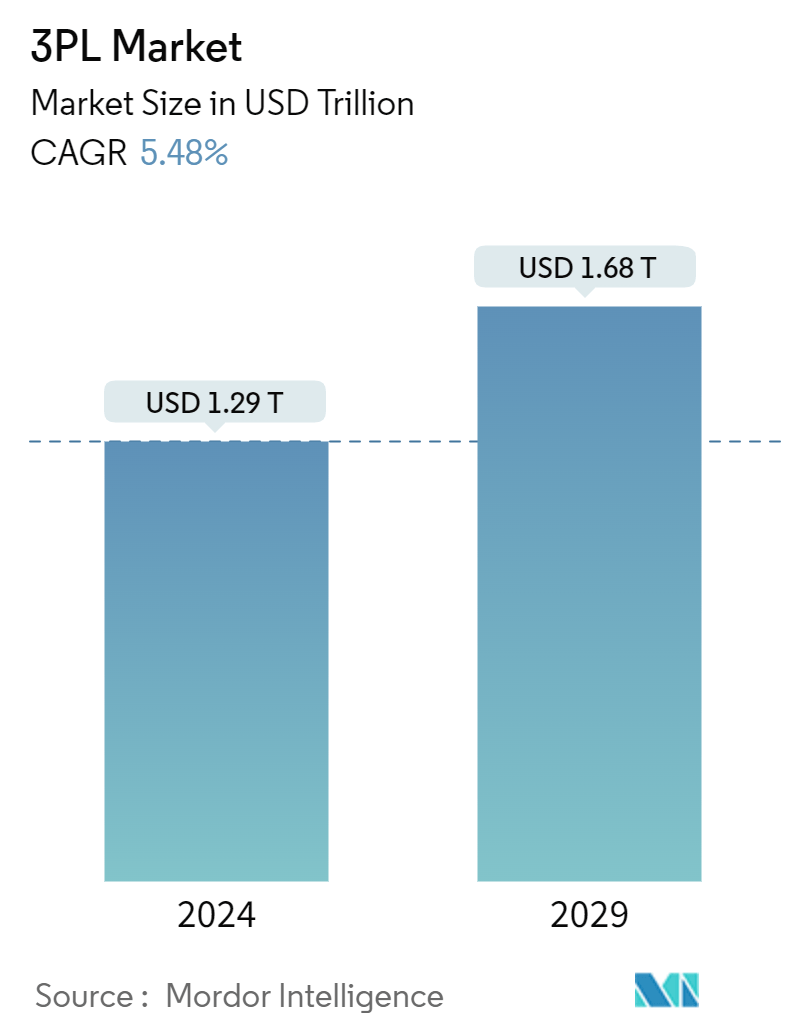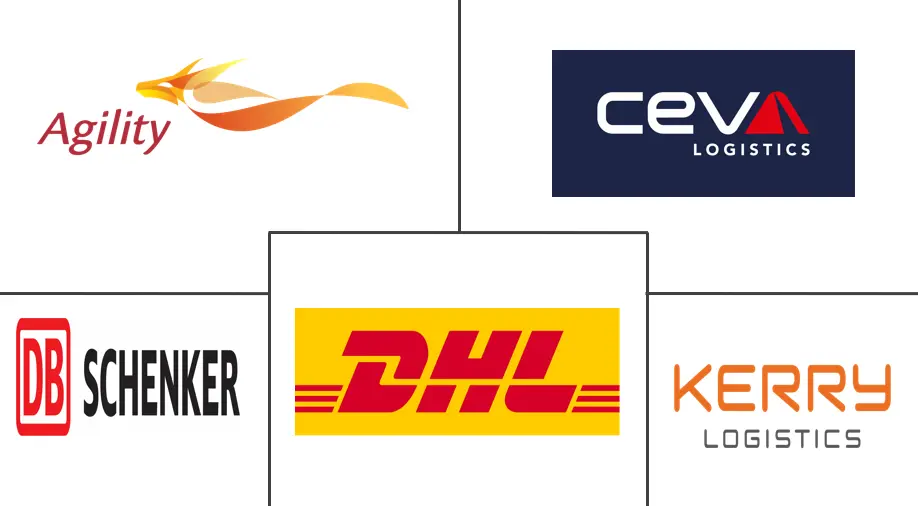Market Size of 3PL Industry

| Study Period | 2020 - 2029 |
| Market Size (2024) | USD 1.29 Trillion |
| Market Size (2029) | USD 1.68 Trillion |
| CAGR (2024 - 2029) | 5.48 % |
| Fastest Growing Market | Asia Pacific |
| Largest Market | Asia Pacific |
Major Players
*Disclaimer: Major Players sorted in no particular order |
3PL Industry Analysis
The 3PL Market size is estimated at USD 1.29 trillion in 2024, and is expected to reach USD 1.68 trillion by 2029, growing at a CAGR of 5.48% during the forecast period (2024-2029).
The third-party logistics market is driven by the order fulfillment services and end-to-end pickup and delivery services provided by the players in the 3PL industry. Furthermore, the market is driven by advanced technology, which is a cutting-edge factor for players to grow in the 3PL industry.
- The logistics industry has undergone several rapid changes in recent years. The trends that began and accelerated in 2020 continued in 2021 and 2022, with increased demand for home delivery and higher consumer expectations than ever before. On the other hand, 2022 presented its own set of challenges in terms of inflation, economic volatility, and ongoing supply chain disruptions. Despite the major disruptions of 2022, there are still many major trends that have continued (and will continue) unabated in the 3PL market. Amazon, for example, increased its dominance by heavily investing in its in-house logistics capabilities.
- Nowadays, shippers want to make more data-driven decisions. As a result, 3PL firms must brace themselves for clients who expect analytics expertise. According to one recent study, 94% of shippers believe analytics are required to ensure complete and on-time order fulfillment and package visibility. 3PLswill increasingly need to focus on generating more analytical insights across their operationsF, like establishing data science capabilities and teams to provide useful insights to their clients and internal teams. Strong data and clear strategies will assist third-party logistics providers in providing shippers with improved traceability and end-to-end visibility across the supply chain. Aside from collecting more data, businesses in the 3PL industry must prioritize cybersecurity and have data protection plans in place.
- The importance of last-mile delivery is well-known to logistics service providers. However, many people are unaware that final mile operations will be a game changer in the coming years. Last-mile deliveries have already dethroned price and product as key differentiators in shopper purchasing decisions. Last-mile delivery is critical for both retaining and acquiring new customers. Simply put, last-mile operations can make or break a company. This has been one of the most important logistics trends for several years, and it shows no signs of abating. Global 3PL companies in the third-party logistics market are working to reduce last-mile delivery distances by locating fulfillment hubs in more accessible locations, such as urban centers.
- Customer retention is one of the most difficult challenges in a highly competitive market, driving businesses to embrace greater picking efficiency, smart inventory management, and rapid replenishment of hot-selling items. The supply chain and logistics domains, particularly within the third-party logistics market, are being transformed by fast data and strong network connectivity. Warehouse management systems (WMS) of today have extensive computing power, large amounts of data storage, and the ability to connect to other critical applications such as enterprise resource planning (ERP) and customer relationship management (CRM). It is no longer enough to simply track shipments; businesses must optimize every step of the process, from raw materials to the production line, marketing, and delivery of the product to the end customer.
Third Party Logistics (3PL) Industry Segmentation
A 3PL (third-party logistics) provider provides outsourced logistics services, including the management of one or more aspects of procurement and fulfillment activities. In the business world, 3PL refers to any service contract that involves storing or shipping items. A complete background analysis of the Global Third-party Logistics Market, including the assessment of the economy and contribution of sectors in the economy, third party logistics market share, market overview, third-party logistics market size, estimation for key segments, emerging trends in the market segments, market dynamics, geographical trends, and COVID-19 impact is included in the report.
The Third-Party Logistics Industry is segmented By Services (Domestic Transportation, International Transportation, and Value-added Warehousing and Distribution), End Users (Automobile, Energy, Manufacturing, Life Science and Healthcare, Retail, Technology, and Other End Users), and Region (North America, South America, Asia-Pacific, Middle East and Africa, and Europe). The report offers third-party logistics market size, share, and forecast values (USD billion) for all the above-mentioned segments.
| By Service | |
| Domestic Transportation Management | |
| International Transportation Management | |
| Value-added Warehousing and Distribution |
| By End User | |
| Automobile | |
| Energy | |
| Manufacturing | |
| Life Science and Healthcare | |
| Retail Technology | |
| Other End Users |
| By Geography | ||||||||||
| ||||||||||
| ||||||||||
| ||||||||||
| ||||||||||
|
3PL Market Size Summary
The third-party logistics (3PL) industry is experiencing significant growth, driven by the increasing demand for order fulfillment and end-to-end delivery services. Advanced technology plays a crucial role in this expansion, enabling 3PL providers to enhance their offerings and meet the evolving needs of shippers. The logistics sector has seen a shift towards data-driven decision-making, with analytics becoming essential for ensuring timely and accurate order fulfillment. This trend is pushing 3PL companies to develop robust data science capabilities and prioritize cybersecurity to protect sensitive information. The importance of last-mile delivery has also risen, with companies focusing on optimizing these operations to retain and attract customers. This has led to strategic investments in urban fulfillment hubs to reduce delivery distances and improve service efficiency.
The e-commerce boom has further propelled the demand for 3PL services, as businesses seek to navigate supply chain disruptions and meet heightened consumer expectations. Global 3PL providers are expanding their offerings to include strategic locations, increased inventory space, and diverse delivery options to accommodate the growing volume of returns and the need for omnichannel logistics. The market is characterized by a fragmented landscape, with major players forming alliances with regional companies to enhance their geographic reach and service capabilities. Technological advancements, such as robotics and AI, are being integrated to streamline operations and reduce costs. As the reliance on 3PLs continues to grow, especially in sectors like grocery and pharmaceuticals, the industry is poised for further innovation and expansion.
3PL Market Size - Table of Contents
-
1. MARKET INSIGHTS AND DYNAMICS
-
1.1 Market Overview
-
1.2 Technological Developments in the Logistics Sector
-
1.3 Insights into E-commerce Business
-
1.4 Demand From Other Segments, such as CEP, Last Mile Delivery, Cold Chain Logistics, etc.
-
1.5 General Trends in the Warehousing Market
-
1.6 Market Dynamics
-
1.6.1 Drivers
-
1.6.2 Restraints
-
1.6.3 Opportunities
-
-
1.7 Industry Attractiveness- Porter's Five Forces Analysis
-
1.7.1 Threat of New Entrants
-
1.7.2 Bargaining Power of Buyers/Consumers
-
1.7.3 Bargaining Power of Suppliers
-
1.7.4 Threat of Substitute Products
-
1.7.5 Intensity of Competitive Rivalry
-
-
1.8 Impact of COVID-19 on the Market
-
-
2. MARKET SEGMENTATION
-
2.1 By Service
-
2.1.1 Domestic Transportation Management
-
2.1.2 International Transportation Management
-
2.1.3 Value-added Warehousing and Distribution
-
-
2.2 By End User
-
2.2.1 Automobile
-
2.2.2 Energy
-
2.2.3 Manufacturing
-
2.2.4 Life Science and Healthcare
-
2.2.5 Retail Technology
-
2.2.6 Other End Users
-
-
2.3 By Geography
-
2.3.1 North America
-
2.3.1.1 United States
-
2.3.1.2 Canada
-
2.3.1.3 Mexico
-
-
2.3.2 South America
-
2.3.2.1 Brazil
-
2.3.2.2 Argentina
-
2.3.2.3 Rest of South America
-
-
2.3.3 Asia-Pacific
-
2.3.3.1 India
-
2.3.3.2 China
-
2.3.3.3 Singapore
-
2.3.3.4 Japan
-
2.3.3.5 South Korea
-
2.3.3.6 Vietnam
-
2.3.3.7 Australia
-
2.3.3.8 Rest of Asia-Pacific
-
-
2.3.4 Middle-East and Africa
-
2.3.4.1 South Africa
-
2.3.4.2 United Arab Emirates
-
2.3.4.3 Saudi Arabia
-
2.3.4.4 Egypt
-
2.3.4.5 Rest of Middle-East and Africa
-
-
2.3.5 Europe
-
2.3.5.1 Germany
-
2.3.5.2 Spain
-
2.3.5.3 France
-
2.3.5.4 Russia
-
2.3.5.5 United Kingdom
-
2.3.5.6 Rest of Europe
-
-
-
3PL Market Size FAQs
How big is the Global 3PL Market?
The Global 3PL Market size is expected to reach USD 1.29 trillion in 2024 and grow at a CAGR of 5.48% to reach USD 1.68 trillion by 2029.
What is the current Global 3PL Market size?
In 2024, the Global 3PL Market size is expected to reach USD 1.29 trillion.

